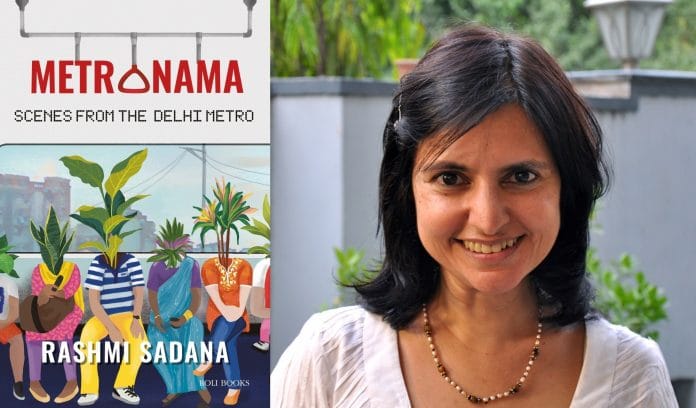When an urban anthropologist from a top US university casts her trained eye on the Delhi Metro and goes into its social dimensions and intricacies, you can be sure of not just “a blurring of the static and the kinetic, but a relationship between them, a meeting of multiple mobilities”. The outcome is Metronama (Lotus/Roli) by Rashmi
Sadana, an Associate Professor of Anthropology at Virginia’s George Mason University, who spent five years in India on teaching assignments in New Delhi and Chennai. Stationed in the national capital, she travelled extensively on the system, and shares the “experiences of Metro riders and how those experiences intersect with larger issues of urban planning in Delhi”.
“The idea for the book came when I first rode the Delhi Metro in 2006,” Sadana revealed. “I was a joy-rider like so many others but also an urban anthropologist. I immediately knew the Metro would be my next project. It was a real “a-ha” moment. I thought, this Metro is going to be a game-changer for so many people in the city, and it’s also going to change how the city looks and feels.”
She went on, “As a woman who has gone around Delhi on foot, in auto-rickshaws, in buses, and in cars for decades, I also knew that for women especially this was going to increase their sense of mobility and freedom in the city. That was exciting.“
She also studied the Metro as it was expanding, describing the physical impact that each new construction phase of the Metro had on “a changing city on the move”.
“What I loved most about writing this book was how it enabled me to write about so many parts of the city, such as Lajpat Nagar (where I lived when I was doing the research for the book), Defence Colony, Greater Kailash, Hauz Khas, Jangpura, Nehru Place, Okhla, Mandi House, Dwarka, Old Delhi, Vasant Kunj, Saket, and Metro stations all the way to the ends of the lines in Haryana and Uttar Pradesh, including Noida and Gurugram.”
“I covered posh and less posh areas, formal colonies and informal settlements, crowded and less crowded places. In some scenes in the book, I’m sitting talking to someone in Dilli Haat or at a Cafe Coffee Day in Connaught Place or South Ex, and in others I’m walking in the lanes of Trilokpuri or am sitting outside next to cow dung patties in Mundka. This is Delhi, and the book shows how all these places are connected,” Sadana explained.
“For some Dilliwalas, the novelty of riding the Metro came from the fact that it was in India, and they could compare it to what they had only ever experienced abroad, in cities like London or Singapore. For most in the city, it was their first experience of high-speed underground rail travel. For still others, it was the first time they had ridden an escalator. For all, the system had rearranged city space and their experience of time. In this solid state-of-art structure, a new form of fleetingness took shape, a multitude of instances, a moving city,” Sadana writes.
“Delhi has the largest square acreage of any city in India, incorporating villages and wildlife, as well as diverse sensibilities, from rural mind-sets to middle-class aspirations and globalised consumerism. The Metro joins and cuts across these spaces.” The book comprises 75 short stories or “scenes” that “readers can read in little bits, scene-by-scene”, Sadana described. “The form of the book mimics the stops and starts of the Metro itself. My point is to relay the brevity and quickness of Metro rides alongside the heaviness and depth of such a transport infrastructure. So, in a way, readers will experience the book as people in Delhi experience the Metro,” Sadana concluded.
IANS




